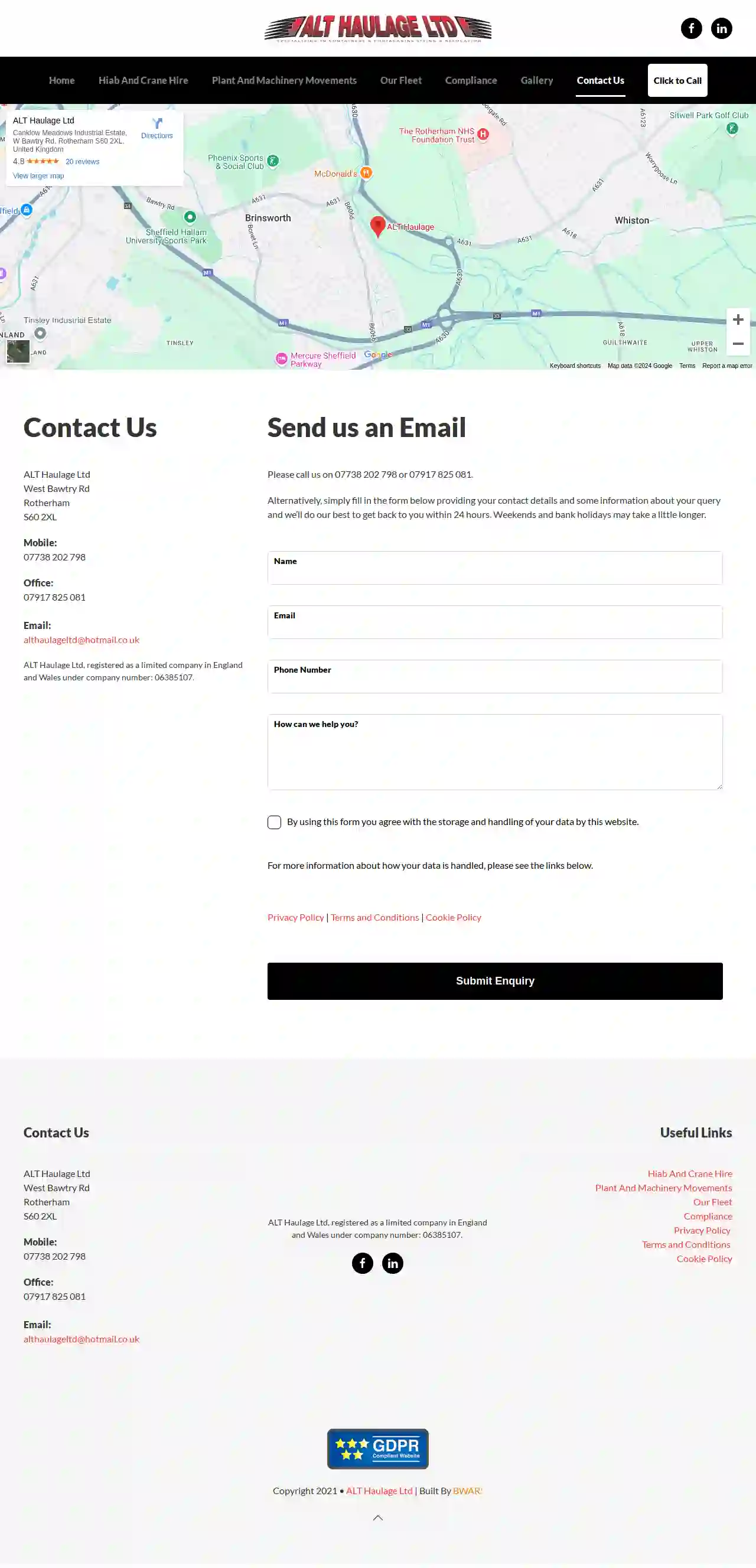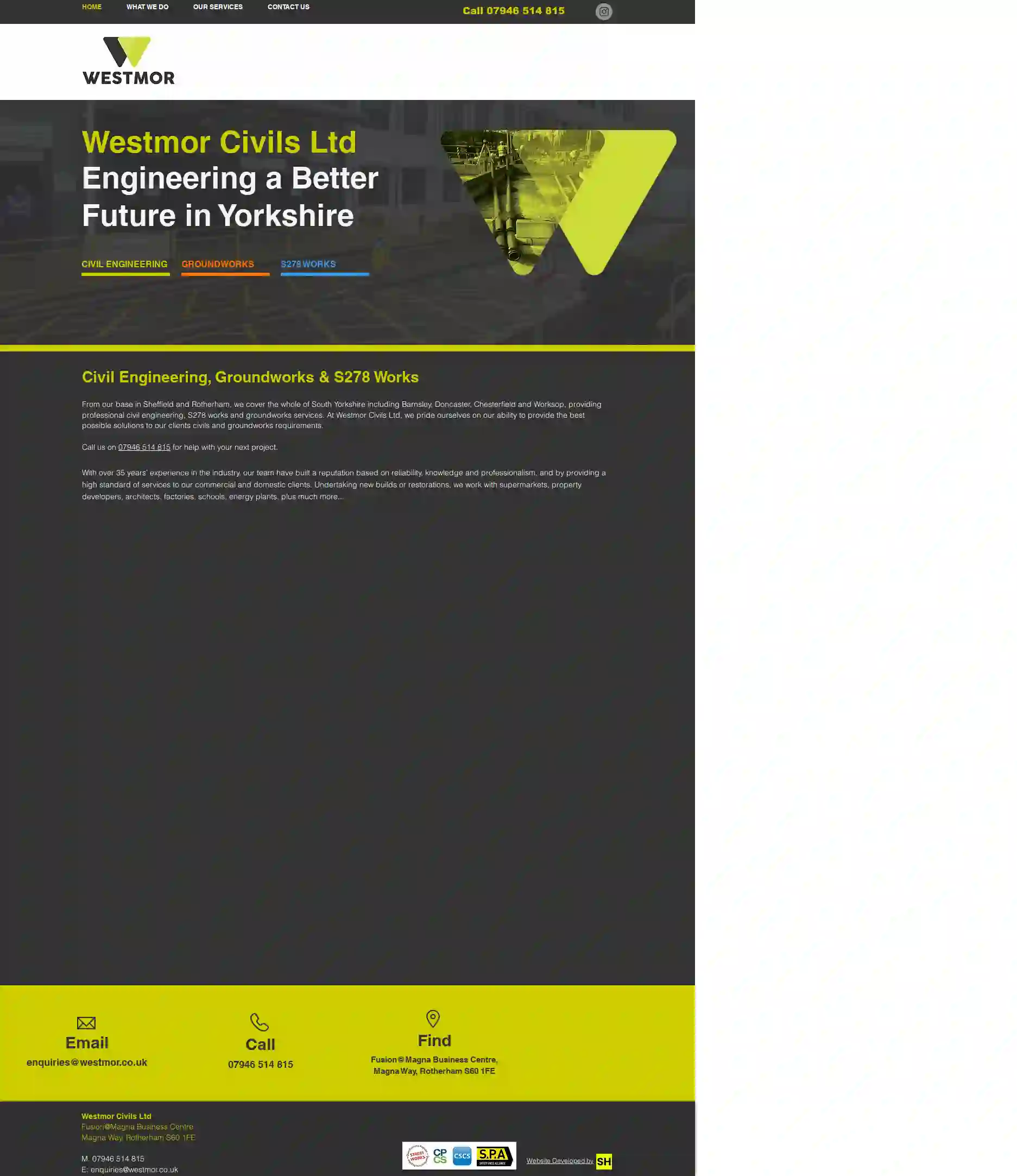Excavation Contractors Dinnington
Top Trenching Services in Dinnington
Receive 3 FREE Excavating Contractors quotes for your project today! Compare profiles, reviews, accreditations, portfolio, etc... and choose the best deal.

Bespoke Builders York
Rotherham, GBAbout South Yorkshire Building Network Your building project deserves the best … Highest standard project management and workmanship Carefully matched to existing building style and materials Compliant with building regulations and codes of practice. Members of the South Yorkshire Building Network can undertake any construction project in South Yorkshire, and nothing is too small or too complicated. Be it renovations, woodwork, bathroom and kitchen fitting, extensions and conversions, plumbing or joinery, our approved panel of building contractors are here to build your perfect home using the latest designs, highest quality materials and all of our expertise! Our experienced builders will complete each stage of your domestic or commercial project, from the conception of the plumbing and heating system to the decorations to complicated electrical wiring. If you are looking for local builders in South Yorkshire, get in touch today. Our members are competitively priced with an excellent track record of customer satisfaction.
- Services
- Why Us?
- Gallery
Get Quote
SB Building & Landscaping
4.821 reviewsWesterton Drive, Bramley, S66 1WU, GBWelcome to SB Building & Landscaping For the past 15 years, we have been providing expert solutions for transforming spaces into functional and aesthetically pleasing environments. Our team of skilled professionals has a wealth of experience in all aspects of building and landscaping, ensuring that every project is completed to the highest standards. Whether you are looking to add an extension to your home, renovate an outdoor area, or undertake a complete building project, we have the expertise to bring your vision to life.
- Services
- Why Us?
- Gallery
Get Quote
Mini Digger & Dumper
51 reviewsRotherham, GBTake the strain out of garden groundworking in Rotherham with S&G Mini Digger Hire Whether you're looking for mini digger hire, a dump truck to get some heavy work done, or a chainsaw to clear trees on your property; if you're looking for great prices on ground works vehicle and machinery hire throughout the Rotherham and Sheffield areas you should call S&G today. Setting a high standard for vehicle hire We all want our homes and gardens to look their best, but getting them that way can be back-breaking work. From fantastic fencing or demolishing unwanted buildings in your garden, to manned or unmanned mini digger hire; S&G have many ways to take the hassle out of having a handsome garden. Losing your mind over leaks in your home? Leaks in your water system could be wasting hundreds of your hard-earned pounds every year without you even knowing. That's why S&G have been carrying out leak detection for homeowners in throughout Rotherham and Sheffield for over 35 years. Call us today to track down those costly leaks.
- Services
- Why Us?
- Gallery
Get Quote
S and G Mini Digger Hire
51 reviewsRotherham, GBTake the strain out of garden groundworking in Rotherham with S&G Mini Digger Hire Whether you're looking for mini digger hire, a dump truck to get some heavy work done, or a chainsaw to clear trees on your property; if you're looking for great prices on ground works vehicle and machinery hire throughout the Rotherham and Sheffield areas you should call S&G today. Setting a high standard for vehicle hire We all want our homes and gardens to look their best, but getting them that way can be back-breaking work. From fantastic fencing or demolishing unwanted buildings in your garden, to manned or unmanned mini digger hire; S&G have many ways to take the hassle out of having a handsome garden. Losing your mind over leaks in your home? Leaks in your water system could be wasting hundreds of your hard-earned pounds every year without you even knowing. That's why S&G have been carrying out leak detection for homeowners in throughout Rotherham and Sheffield for over 35 years. Call us today to track down those costly leaks.
- Services
- Why Us?
- Gallery
Get Quote
Hallamshire Paving
51 reviewsRotherham, GBAbout Us Namesco is a leading provider of domain names, web hosting, and other online services. We offer a wide range of products and services to meet the needs of businesses of all sizes. We are committed to providing our customers with the best possible service and support. We are a team of experienced professionals who are passionate about helping our customers succeed online. We are committed to providing our customers with the best possible service and support. We are a team of experienced professionals who are passionate about helping our customers succeed online. We are committed to providing our customers with the best possible service and support. We are a team of experienced professionals who are passionate about helping our customers succeed online. We are committed to providing our customers with the best possible service and support. We are a team of experienced professionals who are passionate about helping our customers succeed online. We are committed to providing our customers with the best possible service and support. We are a team of experienced professionals who are passionate about helping our customers succeed online.
- Services
- Why Us?
- Gallery
Get Quote
onspotmix
125 james St, Rotherham, 125 james St Rotherham, S60 1JZ, GBQuality Assured Ready Mix Concrete Mix On Spot Volumetrics readymix concrete is always committed to provide best services to customer customers. At Volumetrics Concrete, we know that meeting deadlines means everything in the world of construction, but we don’t believe that you should have to pay more for the privilege of a fast delivery in SHEFFIELD, ROTHERHAM, DONCASTER, BARNSLEY, CHESTERFIELD and surrounding areas. All concrete suppliers should offer exceptional reliability as standard, which is why even though we can usually offer same-day deliveries for any required quantity, we remain one of Sheffield’s most competitively priced companies.We’ve prioritised speed and quality since opening our doors, and our services have only become increasingly efficient as we’ve grown. Nowadays, we operate a fleet of trucks that all range in size from 1m to 10m, ensuring we can handle any order request and still reach your location within hours. The next time you need concrete in Sheffield, you needn’t look any further than Volumetrics readymix Concrete. From major construction projects to smaller residential projects, our quality assured company are capable of providing concrete to the job where the use of concrete is necessary. Even out of hours or on weekends, Volumetrics Readymix Concrete can do their uppermost to supply the concrete that you require. Feel free to take a look through our website and discover more about the services that we offer. Quality And Experience Volumetric Concrete is a family run business and since our establishment we have been dedicated to providing a high standard of product to our clients. With a comprehensive, modern fleet and forty years of experience in the industry, we combine modern advancements with knowledge and skill to bring you a cost effective and reliable service with quality assured. Our ready mix concrete gives us precise control over how much concrete is made for your project. So, how much do you need? The bulk of your concrete will probably be going into a square area, so you calculate how much concrete you need with a few measurements:When calculating the amount of concrete required, we recommend adding an extra 5-10% onto your total estimate to allow for possible errors as well as spillage or over excavation / uneven surfaces. Volumetrics concrete are always looking to provide a best in class service to our customers, in the most efficient way possible. We are pleased to announce that we have expanded our fleet, with a Truck Mixer Pump Hybrid.
- Services
- Why Us?
- Gallery
Get Quote
Mabey Hire Depot - Dewsbury
4.210 reviewsRotherham, GBTrench Struts Trench struts are used to support trench walls during construction, preventing vertical loads from collapsing. Our trench struts are designed for bracing timber walings against trench sheets and are ideally suited for small, shallow trench excavations. View our full range of Groundworks support equipment. Features Safe Working Load - 30kN Available in lengths ranging from 300-1040mm Strut end plates have bent corners - dig into the timber and prevent movement Our Adjustable Trench Struts Our trench struts provide maximum support for trench walls, securely holding shallow trenches in place during construction. This helps create a safe working environment, protecting workers from potential hazards such as trench wall collapse. Ideally suited for small, shallow trench excavations, our trench struts are fully adjustable to fit your requirements. This makes our struts easy to install, with a lightweight design that makes handling a breeze. Our trench struts are complete with a clawed design, helping to hold timber waling in place more securely and prevent unwanted movement. We do not offer engineering designs featuring these products. Hire Trench Struts With a huge range of groundworks support equipment available, hire trench struts from your local depot. Resources Revit BIM AutoCAD User guide Frequently hired together View our extensive range of accompanying groundworks support equipment, including trench sheets available to hire with trench struts.
- Services
- Why Us?
- Gallery
Get Quote
ALT Haulage Ltd
4.820 reviewsWest Bawtry Rd, Rotherham, S60 2XL, GBAbout ALT Haulage ALT Haulage is a family-run business established in 2007. We provide a full range of haulage services throughout the UK & Internationally. Based in Rotherham, South Yorkshire, our number one aim is to provide a reliable, efficient, and professional service. All our drivers and crane operators have a number of years of experience. At ALT, we understand the importance of delivering goods to site in perfect condition and on time. We strive to provide this service and go the extra mile to ensure our customers are 100% satisfied. We believe that customer satisfaction is paramount to the success of ALT.
- Services
- Why Us?
- Accreditations
- Testimonials
- Gallery
Get Quote
Westmor Civils ltd
Fusion@Magna Business Centre, Magna Way, Rotherham, Fusion@Magna Business Centre Magna Way, S60 1FE, GBEngineering a Better Future in Yorkshire From our base in Sheffield and Rotherham, we cover the whole of South Yorkshire including Barnsley, Doncaster, Chesterfield and Worksop, providing professional civil engineering, S278 works and groundworks services. At Westmor Civils Ltd, we pride ourselves on our ability to provide the best possible solutions to our clients civils and groundworks requirements. With over 35 years’ experience in the industry, our team have built a reputation based on reliability, knowledge and professionalism, and by providing a high standard of services to our commercial and domestic clients. Undertaking new builds or restorations, we work with supermarkets, property developers, architects, factories, schools, energy plants, plus much more...
- Services
- Why Us?
- Gallery
Get Quote
Demex
3.511 reviewsBernera Works, Psalters Lane, Bernera Works Psalters Lane Holmes Rotherham, Rotherham, S61 1DQ, GBDemex LTD, 48 years since the start. At the forefront of the demolition industry for over 48 years Demex Ltd offers a high degree of expert knowledge and competency to carry out all demolition related activities. Demex Limited is a demolition / asbestos removal specialist company working within the domestic and commercial sectors. We have over 48 years experience working in Yorkshire, North West Region, North East Region, Humberside and East Midlands from our offices in Rotherham. We work principally 'in house' for our demolition operations or directly with our clients which are in the manufacturing, construction, public and private sectors, whether individual domestic properties, small businesses or large scale commercial premises. We provide a professional, competitive and prompt asbestos removal service, alongside demolition. Our Credentials Our licence granted by the Health and Safety Executive allows us to work with notifiable asbestos materials including all types of insulation and asbestos insulation board for the purpose of removal (Licence Number 841801010). Licence to transport hazardous waste (Waste Carriers Registration Number CBDU93127), awarded by the Environment Agency - allowing us to safely transport and dispose of hazardous asbestos materials once removed. We also hold Health & Safety accreditations including ‘CHAS’ and ‘Constructionline’. Our office is centrally located in Rotherham South Yorkshire making us ideally placed within the M1 corridor to deliver projects in Yorkshire, NW Region, North East Region, Humberside and East Midlands, plus our location ensures nationwide coverage.
- Services
- Why Us?
- Accreditations
- Gallery
Get Quote
Over 13,059+ Excavation Companies in our network
Our excavation pros operate in Dinnington and beyond!
ExcavationHQ has curated and vetted Top Excavation Contractors near Dinnington. Find a top & trustworthy business today.
Frequently Asked Questions About Excavation Contractors
- Trench Collapses: Unstable trench walls can cave in, posing a severe risk to workers. Proper shoring and sloping are crucial safety measures.
- Utility Damage: Striking underground utilities (gas, water, electric) can cause leaks, explosions, or electrocution. Accurate utility locates and careful digging are essential.
- Falling Objects: Materials or equipment falling into excavations can injure workers. Securing work areas and using appropriate safety gear is vital.
- Equipment Accidents: Operating heavy machinery involves risks of rollovers, collisions, or mechanical failures. Trained operators and proper equipment maintenance are critical.
- Environmental Hazards: Excavated soil might contain hazardous materials (asbestos, lead). Proper testing and disposal procedures are necessary.
- Excavators: Versatile machines with a bucket, arm, and rotating cab for digging, lifting, and moving earth.
- Backhoes: Similar to excavators but with a digging bucket on the back and a loader bucket on the front, ideal for trenching and smaller excavations.
- Bulldozers: Powerful machines with a large blade for pushing earth, clearing land, and leveling surfaces.
- Skid Steers: Compact and maneuverable loaders with various attachments (buckets, forks) for digging, loading, and grading in tight spaces.
- Trenchers: Specialized machines for digging narrow trenches for utilities.
- Dump Trucks: Vehicles for hauling excavated material to disposal sites.
- Determine the Area: Measure the length and width of the area you want to fill. Multiply them to get the area in square feet (or meters).
- Determine the Depth: Measure the difference between the existing grade and the desired grade (how much you need to raise the ground). This is the depth of fill required.
- Calculate Volume: Multiply the area (step 1) by the depth (step 2) to get the volume in cubic feet (or meters).
- Account for Compaction: Fill dirt compacts when it settles, so add 10% to 25% to the calculated volume to account for compaction. The exact percentage depends on the type of fill material.
- Experience: Choose contractors with a proven track record and years of experience in excavation projects similar to yours.
- Licensing and Insurance: Verify that they are properly licensed to operate in your area and carry adequate insurance to protect you from liability in case of accidents or damage.
- Equipment and Resources: Ensure they have the necessary equipment and resources to handle your project efficiently and safely.
- Positive Reviews and References: Check online reviews and testimonials from previous customers. Request references and contact them to inquire about their experience with the contractor.
- Professionalism: Opt for a company that communicates clearly, provides detailed and transparent estimates, and has a responsive and courteous team.
What are the risks associated with excavation?
What equipment is used for excavation?
How do I calculate how much dirt I need for fill?
How do I find a good excavation contractor?
What are the risks associated with excavation?
- Trench Collapses: Unstable trench walls can cave in, posing a severe risk to workers. Proper shoring and sloping are crucial safety measures.
- Utility Damage: Striking underground utilities (gas, water, electric) can cause leaks, explosions, or electrocution. Accurate utility locates and careful digging are essential.
- Falling Objects: Materials or equipment falling into excavations can injure workers. Securing work areas and using appropriate safety gear is vital.
- Equipment Accidents: Operating heavy machinery involves risks of rollovers, collisions, or mechanical failures. Trained operators and proper equipment maintenance are critical.
- Environmental Hazards: Excavated soil might contain hazardous materials (asbestos, lead). Proper testing and disposal procedures are necessary.
What equipment is used for excavation?
- Excavators: Versatile machines with a bucket, arm, and rotating cab for digging, lifting, and moving earth.
- Backhoes: Similar to excavators but with a digging bucket on the back and a loader bucket on the front, ideal for trenching and smaller excavations.
- Bulldozers: Powerful machines with a large blade for pushing earth, clearing land, and leveling surfaces.
- Skid Steers: Compact and maneuverable loaders with various attachments (buckets, forks) for digging, loading, and grading in tight spaces.
- Trenchers: Specialized machines for digging narrow trenches for utilities.
- Dump Trucks: Vehicles for hauling excavated material to disposal sites.
How do I calculate how much dirt I need for fill?
- Determine the Area: Measure the length and width of the area you want to fill. Multiply them to get the area in square feet (or meters).
- Determine the Depth: Measure the difference between the existing grade and the desired grade (how much you need to raise the ground). This is the depth of fill required.
- Calculate Volume: Multiply the area (step 1) by the depth (step 2) to get the volume in cubic feet (or meters).
- Account for Compaction: Fill dirt compacts when it settles, so add 10% to 25% to the calculated volume to account for compaction. The exact percentage depends on the type of fill material.
How do I find a good excavation contractor?
- Experience: Choose contractors with a proven track record and years of experience in excavation projects similar to yours.
- Licensing and Insurance: Verify that they are properly licensed to operate in your area and carry adequate insurance to protect you from liability in case of accidents or damage.
- Equipment and Resources: Ensure they have the necessary equipment and resources to handle your project efficiently and safely.
- Positive Reviews and References: Check online reviews and testimonials from previous customers. Request references and contact them to inquire about their experience with the contractor.
- Professionalism: Opt for a company that communicates clearly, provides detailed and transparent estimates, and has a responsive and courteous team.